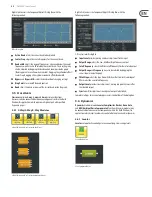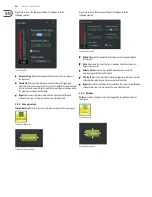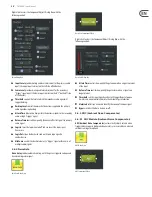
26
DM8000 User Manual
Right-click to access the Component Object’s Dialog Box, with the
following controls:
ANC Dialog Box
NOTE
: The primary signal is referred to as the “Program” signal, while the
secondary reference signal is referred to as the “Ambient” signal.
•
Program Mute
turns the input signal on or off.
•
Program Level
adjusts the relative input volume.
•
Program Label
provides a customizable label for the source of the primary
Program input signal.
•
Prog Meter
displays the current input level.
•
Ambient Mute
turns the ambient input signal on/off.
•
Ambient Level
adjusts the input volume for the Ambient input.
•
Ambient Threshold
sets the Ambient noise level at which gain increases
are applied to the Program signal.
•
Ambient Response
sets the time period during which the ANC module
calculates the working average of Ambient level fluctuations.
•
Ambient Label
provides a customizable label for the Ambient
signal source.
•
Amb Meter
displays the current Ambient input level.
•
Gain Min
determines the minimum Program output gain for periods of low
ambient noise.
•
Gain Max
determines the maximum Program output gain for periods of
high ambient noise.
•
Gain Ratio
determines how much the Program volume will increase in
response to a given noise increase in the Ambient reference signal.
•
Gain Time
determines the amount of time required for the Program gain to
change between Min and Max settings.
•
Gain Meter
displays the current gain compensation being applied to the
Program signal.
•
Bypass
switches off the Ambient Noise Compensator.
3.6.5.2 Making Connections
1. Route the Program signal into the Program Input terminal (top left) on the
ANC Component Object and set the input gain (see “Setting Gain Min and
Gain Max” below).
2. Route the Ambient signal into the Ambient Input (bottom left, marked
with an “A”) on the ANC Component Object. This Ambient signal should be
derived from either a single dedicated sensing microphone, or from an array
of sensing microphones feeding a common Mixer module. For best results,
the ANC Ambient levels should be set when the ambient noise in the room is
minimized and the Amb Meter reads at least -60 dBu.
3. Connect the ANC Component Object’s output terminal to the input terminal
of the final Output Component Object in the signal path (DM8000 Output
6 Channel, UltraNet Out, or USB Out).. ANC should be the last Component
Object in the signal path before routing the signal to outputs. For consistent
performance once levels have been set, do not subsequently adjust the level
settings at the outputs, amplifiers, or speakers.
3.6.5.3 Setting Gain Min and Gain Max
For best results, you should set Program gain levels by using a relatively constant
Program source signal. If the actual source Program signal is not constant
enough, pink noise can also be used to set levels (provided the pink noise
approximates the highest Program level that you expect will be routed into the
ANC module).
1. Adjust the Gain Min and Gain Max levels to your desired settings for the
Program signal. Note that the Gain Min setting represents the minimum
constant gain that the ANC module will apply to the Program input signal
when the Ambient signal level drops below the Ambient Threshold.
Similarly, the Max Gain setting represents the maximum amount of gain that
you expect the ANC module will ever apply to the Program input level.
2. If Gain Min and Gain Max are not known in advance, you may determine
these settings by monitoring the ANC output using this procedure:
a. Set the Ambient Threshold to the maximum setting (+24 dBu)
to make sure the Ambient Input level is below threshold. This maximum
Ambient Threshold setting automatically adjusts the ANC module to
the Min Gain setting. Remember that the Gain Time setting controls
how quickly the ANC module moves the Ambient signal to the
Min Gain setting.
b. Adjust Gain Min until you find the desired maximum output level.
c. Set Gain Max to the output value you have just discovered using
Gain Min.
d. Re-set Gain Min to the value determined in Step 2a.
e. Adjust Gain Min until you have the desired minimum Program level
coming out of the ANC module. Note this Gain Min setting for later use.
3.6.5.4 Setting response Times
1. Adjust Gain Time to figure out how quickly the ANC gain is changing. Gain
Time determines how quickly the ANC module moves from Gain Min to
Gain Max, or vice versa.
2. Adjust the Ambient Response setting to discover how quickly the ANC
module responds to changes in the Ambient input level. Ambient Response
should be set fast enough to respond to significant and sustained changes
in the Ambient signal level, but slow enough to disregard short, transient
changes in the Ambient signal level, such as coughs, bumps, popping sounds
or dropped objects.
NOTE
: The ANC module’s overall responsiveness is controlled by either the Gain
Time setting or Ambient Response setting, whichever is larger/slower.
Содержание DM8000
Страница 65: ......






























